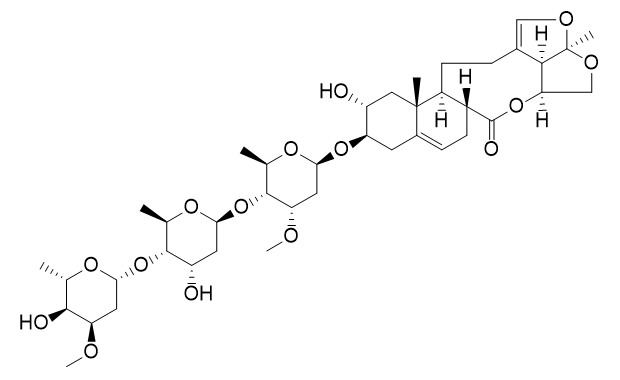Glaucoside C
Anticancer. Glaucoside C was evaluated against the HT-29 and HCT 116 human colon cancer cell lines.
Inquire / Order:
manager@chemfaces.com
Technical Inquiries:
service@chemfaces.com
Tel:
+86-27-84237783
Fax:
+86-27-84254680
Address:
1 Building, No. 83, CheCheng Rd., Wuhan Economic and Technological Development Zone, Wuhan, Hubei 430056, PRC
Providing storage is as stated on the product vial and the vial is kept tightly sealed, the product can be stored for up to
24 months(2-8C).
Wherever possible, you should prepare and use solutions on the same day. However, if you need to make up stock solutions in advance, we recommend that you store the solution as aliquots in tightly sealed vials at -20C. Generally, these will be useable for up to two weeks. Before use, and prior to opening the vial we recommend that you allow your product to equilibrate to room temperature for at least 1 hour.
Need more advice on solubility, usage and handling? Please email to: service@chemfaces.com
The packaging of the product may have turned upside down during transportation, resulting in the natural compounds adhering to the neck or cap of the vial. take the vial out of its packaging and gently shake to let the compounds fall to the bottom of the vial. for liquid products, centrifuge at 200-500 RPM to gather the liquid at the bottom of the vial. try to avoid loss or contamination during handling.
Nutrients.2023, 15(6):1335.
Br J Pharmacol.2018, 175(6):902-923
J Cell Mol Med.2023, jcmm.18071.
Manomaniam Sundaranar University2023, 3859769.
Molecules.2022, 27(7):2093.
Food Chem.2019, 290:286-294
J Appl Biol Chem.2022, 65(4):pp.463-469.
JPC-Journal of Planar Chromatography2023, 36:179-190
Pharmaceuticals (Basel).2024, 17(3):341.
Indian J Pharm Sci.2024, 86(2):736-741.
Related and Featured Products
Magn Reson Chem . 2011 Feb;49(2):83-9
Glaucasides A-C, three saikosaponins from Atriplex glauca L. var. ifiniensis (Caball) Maire[Pubmed:
21254229]
From the roots of Atriplex glauca L. var. ifiniensis (Caball) Maire (syn. of Atriplex parvifolia Lowe var. genuina Maire), three new saikosaponins designated as glaucasides A-C (1-3) were isolated together with the known 3-O-β-D-glucopyranosyl-(1 → 2)-β-D-galactopyranosyl-saikogenin F (4). The structures of the new compounds were elucidated by extensive analysis of one-dimensional and two-dimensional NMR spectroscopy, FABMS, HR-ESIMS and chemical evidence as 13β,28-epoxy-16β,21β-dihydroxyolean-11-en-3β-yl O-β-D-[2-O-sulfate]-glucopyranosyl-(1 → 2)-α-L-arabinopyranoside (1), 13β,28-epoxy-16β,21β-dihydroxyolean-11-en-3β-yl O-β-D-[2-O-sulfate]-glucopyranosyl-(1 → 2)-α-L-arabinopyranosyl 21-O-{4-(secbutylamido)-butanoyl ester} (2) and 3-O-β-D-glucopyranosyl-(1 → 2)-β-D-galactopyranosyl saikogenin G (3). The cytotoxic activities of these compounds were evaluated against the HT-29 and HCT 116 human colon cancer cell lines.
Phytochem Anal . Sep-Oct 2007;18(5):428-35.
Identification and quantification of C21 steroidal saponins from Radix Cynanchi Atrati by high-performance liquid chromatography with evaporative light scattering detection and electrospray mass spectrometric detection[Pubmed:
17624893]
High-performance liquid chromatography coupled with electrospray tandem mass spectrometry (HPLC-ESI/MS) and evaporative light scattering detection (HPLC-ELSD), respectively, has been performed for the simultaneous identification and quantification of six C(21) steroid saponins, including cynanversicoside A, B, D, G, Glaucoside C and glaucogenin C-3-O-beta-d-thevetopyranoside in Radix Cynanchi Atrati. The extraction of the C(21) steroidal saponins was performed using a B-811 Buchi Universal Extraction System in Warm Solvent Mode, and the analyte was concentrated by column chromatography before HPLC analysis. The chromatographic separation was performed on an Agilent Zorbax Extend C(18) analytical column efficiently using gradient elution with acetonitrile and water. The method was validated with acceptable linearities (r > 0.9991) and recoveries (98.2-101.3%). The limits of detection of the C(21) steroid saponins were from 0.2 microg for glaucogenin C-3-O-beta-d-thevetopyranoside to 0.5 microg for cynanversicoside B. The intra- and inter-day precisions of the method were evaluated and were less than 5.0%. The method was successfully used to analyse 20 batches of Radix Cynanchi Atrati. The content of C(21) steroid saponins in the plant material varied significantly from habitat to habitat, confirming the necessity to control the quality of Radix Cynanchi Atrati during its preparation and application in the clinic.



